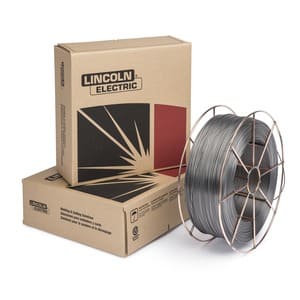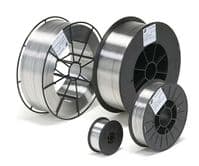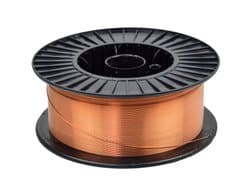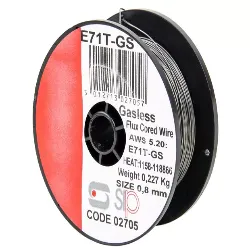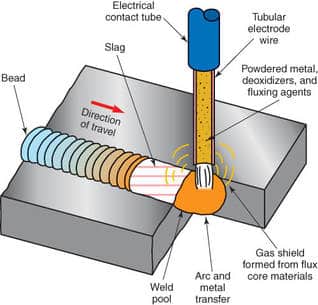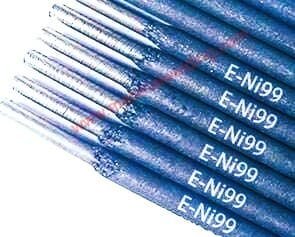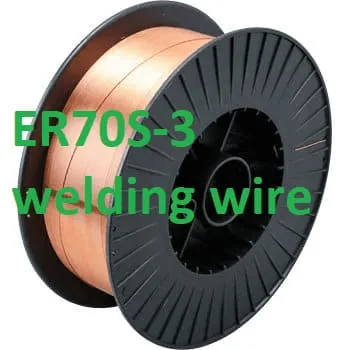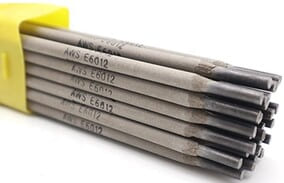E71T-GS vs E71T-11
There are a few main things to consider when choosing between E71T-GS vs E71T-11 flux-cored wires.
Both E71T-GS and E71T-11 are flux cored wire for mild steel and carbon steel welding as per AWS A5.20 specification.
But how you can decide which one is better and at what expense?
The main differences between E71T-GS vs E71T-11 are given in the below table reference to AWS A5.20 welding wire specification.
| E71T-GS | E71T-11 | |
|---|---|---|
| Wire Specification | AWS A 5.20 | AWS A 5.20 |
| Wire Classification | E71T-GS | E71T-11 |
| Welding Polarity | DCEN | DCEN |
| Welding Gas | Not required (Self-shielded wire) | Not required (Self-shielded wire) |
| Welding Position | All positions | All positions except vertical uphill |
| Applications | Single pass welds only | Single pass & multi-pass welds |
| Weld Tensile Strength | 70 Ksi minimum | 70- 95 Ksi |
| % Elongation | Minimum 22% | Not specified |
| Chemical Composition | Given in AWS A5.20 | Not specified |
E71T-GS Meaning
E71T-GS is a carbon steel welding, self-shielded flux core welding wire as per AWS A5.20 Specification.
E71T-GS is the wire classification number for this wire. The complete meaning of E71T-GS is:
- ‘E’ means Electrode
- ‘7’ means, minimum tensile strength in psi multiplied by 1000
- ‘1’ means for all welding positions
- ‘T’ means Tubular flux cored electrode
- ‘GS’ Means Usability Characteristics, Refer table 2 in AWS A5.20.
E71T-11 Meaning
E71T-11 is a carbon steel welding, self-shielded flux core welding wire as per AWS A5.20 Specification.
E71T-11 is the wire classification number for this wire. The complete meaning of E71T-11 is:
- ‘E’ means Electrode
- ‘7’ means, minimum tensile strength in psi multiplied by 1000
- ‘1’ means for all welding positions
- ‘T’ means Tubular flux cored electrode
- ’11’ Means Usability Characteristics, Refer table 2 in AWS A5.20.
E71T-11 is a common flux cored wire used for MIG welding thin gauge mild steel. It is good for all position welding and can be used in either the spray transfer or globular transfer mode.
Related Reading: NR-211-Mp vs E71T-1
The advantage of using this wire is that it doesn’t require shielding gas, making it more versatile and convenient than other types of flux cored wires.
Difference Between E71T-11 and E71T-GS
E71T-11 is a gasless, self-shielding MIG wire for all position welding. E71T-GS is a general purpose, all-position Flux cored arc welding (FCAW) wire for mild steel.
Both wires are used on projects that do not require shielding gas and can be used with either a standard 110 volt or 220 volt welder.
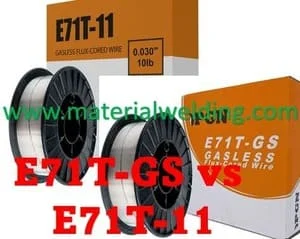
Read More: Welding Gasless MIG- TIG- A New Way to Weld?
The difference between the two wires is that E71T-11 is designed for use with light gauge metal single pass welds, while E71T-GS can be used on thicker gauge metal.
Both the wires are generally used with DCEN polarity thus ensure low heat into the base metal and thus prevent burn-through issues especially when welding sheet metals.
| E71T-GS | E71T-11 | |
|---|---|---|
| Wire Specification | AWS A 5.20 | AWS A 5.20 |
| Wire Classification | E71T-GS | E71T-11 |
| Welding Polarity | DCEN | DCEN |
| Welding Gas | Not required (Self-shielded wire) | Not required (Self-shielded wire) |
| Welding Position | All positions | All positions except vertical uphill |
| Applications | Single pass welds only | Single pass & multi-pass welds |
| Weld Tensile Strength | 70 Ksi minimum | 70- 95 Ksi |
| % Elongation | Minimum 22% | Not specified |
| Chemical Composition | Given in AWS A5.20 | Not specified |
What is E71T-GS used for?
E71T-GS is a self-shielding flux cored wire used for MIG welding on thin gauge mild steel. This wire does not require shielding gas making it more versatile and convenient than other types of flux cored wires.
It can be used in all positions and is best suited for use in the globular transfer mode.
What is E71T-11 used for?
E71T-11 is a common flux cored wire used for MIG welding thin gauge mild steel. It is good for all position welding and can be used in either the spray transfer or globular transfer mode.
The advantage of using this wire is that it doesn’t require shielding gas, making it more versatile and convenient than other types of flux cored wires.
Read more:
- AWS A5.20/A5.20M:2005 (R2015) – Specification for Carbon Steel Electrodes for Flux Cored Arc Welding (ansi.org)
- E71T-GS – Weld WireWeld Wire
- E71T-11 Carbon Steel Self-Shielded Flux-Cored Welding Alloy .030″ 10 lb Spool (harrisproductsgroup.com)
